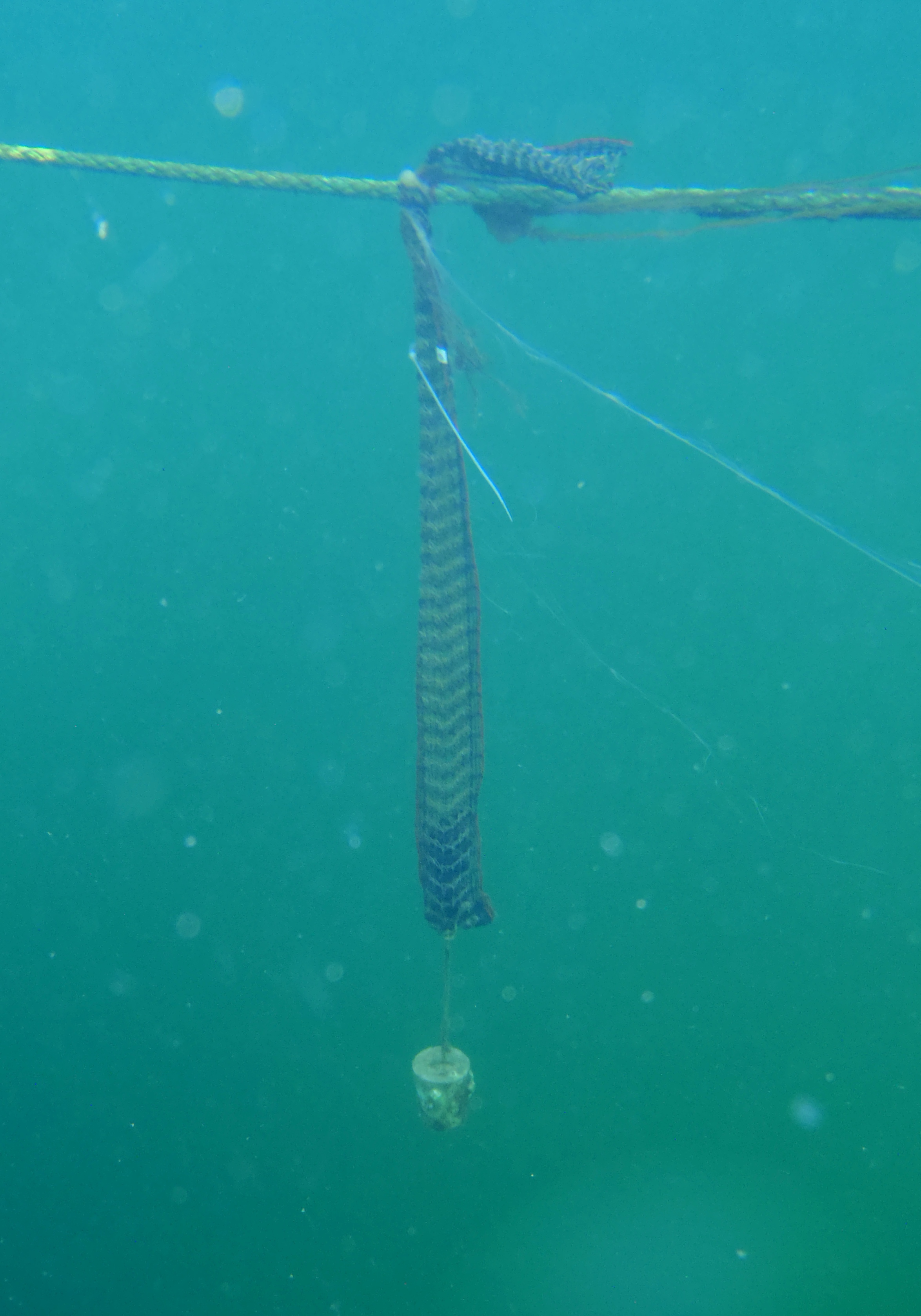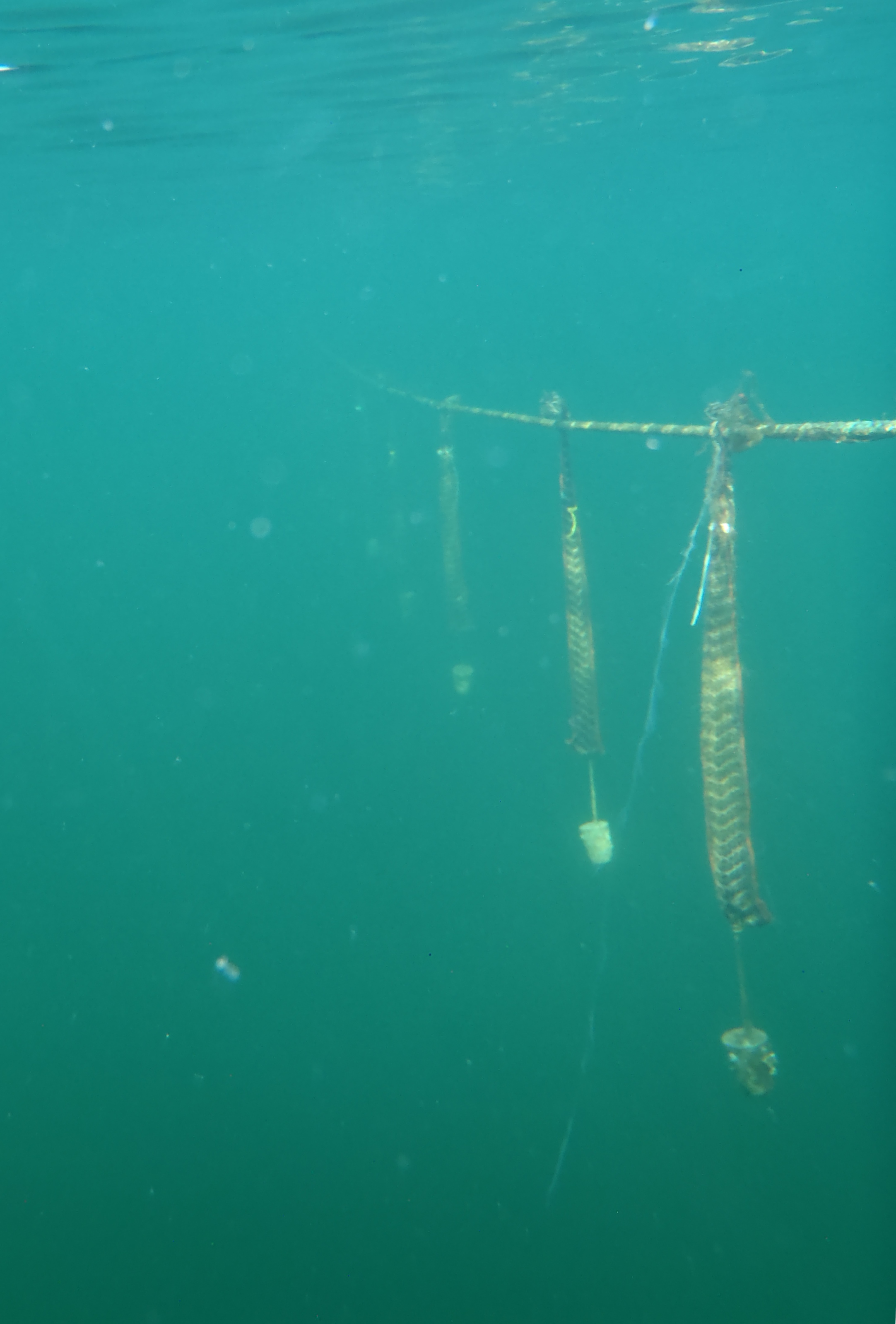Responsible
Professor Hans Ulrik Riisgård, Marine Biological Research Centre, University of Southern Denmark

Fig. 2. Line mussels (left) and ‘Smart-Farm’ nets (middle and right) in the MarBioShell research- and demonstration farm in Great Belt (Kerteminde Bay, Denmark).
Aims
The overall aim of WP2 is to provide the necessary growth energetic information that is needed in WP3 for construction of an easy-to-use production model and objectives are to study growth and bioenergetics in mussels living on diets of heterotrophic ’feed-algae’ and to establish relationships between feed availability and growth in blue mussels of all sizes in the laboratory and in the field.
Scientific personnel
- Professor Hans Ulrik Riisgård (HUR) participates in research activities and is acting as supervisor for a number of Ph.D. and master students involved in this project.
- Associate Professor Niels T. Eriksen (NTE), AAU participates in supervision and research activities.
- Daniel Pleissner (DP) started his 3-year PhD-project on April 1, 2009. Daniel Pleissner will conduct approx. 18 months of research on feeding and bioenergetics in blue mussels at Marine Biological Research Centre (SDU), Kerteminde while the remaining time of his PhD project is allocated to WP2.
- Research assistant Kim Lundgreen, SDU works full-time on MarBioShell, carrying out all-round work in lab and field, and he assists the scientific leader Hans Ulrik Riisgård in the administration of MarBioShell.
- Inma Martín Arnan from University of Murcia, Spain has worked for 6 months in 2008-2009 within MarBioShell as a Leonardo da Vinci grant trainee.
- Ana Orts Pérez from University Miguel Hernandez of Elche, Alicante, Spain worked as a Leonardo da Vinci grant trainee for 6 month from August 2009 to January 2010.
- Isabel Barreiro Saavedra from University Alcalá de Henares, Madrid, Spain worked as a Leonardo da Vinci grant trainee from January 2010 to July 2010. She was afterwards employed on the project for 4 month to work as a research assistant from Septmeber 2010 to December 2010.
- Sandrine Serre from National Agronomic Engineering Post Graduate School Toulouse, France worked within the MarBioShell project as a research assistant for 4 month, from September to December 2010.
- Line Bøttiger, master student studied the effect of salinity on growth of mussels. Graduated (M.Sc.) in March 2011.
- Parnuna Egede, master student studied food uptake and growth of blue mussels. Graduated (M.Sc.) in September 2010.
- Gorm Rønved Larsen, M.Sc. worked 2 months (October and November 2010) as a consultant obtaining and treating environmental monitoring data on phytoplankton biomass in Great Bet and Limfjorden for the last 20 years.
- Lærke Arentoft Johansen, bachelor student who worked with outreach within the project to different target groups. Project finished September 2010.
- Sabrina Maria Nothlev Sørensen, bachelor student who worked with outreach within the project to different target groups. Project finished September 2010.
- Jakob Sten Knudsen, bachelor student studied the effects of extremely high algal concentrations on filtration rate and digestion in blue mussels. Project finished in November 2011.
- Maria Àngeles Provencio López from University of Murcia, Spain, is currently working as a Leonardo da Vinci grant trainee from November 2011 until May 2012.
- Florian Lüskow, B.Sc. from University of Bremen, Germany, will be working on effects of salinity-changing rates on feeding behaviour of blue mussels in the period March to June 2012.
Past activities (Jan 2008 – Mar 2012)
- Investigations of growth and bioenergetics in blue mussels fed phototrophic Rhodomonas sp. since mid-2008 at Marine Biological Research Centre, Kerteminde.
- Investigations of growth and bioenergetics in blue mussels fed heterotrophic Galdieria sulphuraria during spring 2009 at Marine Biological Research Centre, Kerteminde.
- Design and test of experimental set-up for automatic control of algal concentration and continuous detection of filtering activity and feeding rates in blue mussels, during 2010 at Marine Biological Research Centre, Kerteminde.
- Feeding and growth experiments using phototrophic Rhodomonas sp. and heterotrophic Galdieria sulphuraria have been carried out at the Marine Biological Research Centre, Kerteminde from mid-2008 to November 2010.
- Two students (Lasse Tellerup Hansen & Michala Karlsen Møller, Tek-Fak-SDU KBM) finished their projects on blue mussels (7. semester afgangsprojekt) by the end of 2008.
- Master student Parnuna Egede, SDU, has carried out growth experiments for determination of satiation degree in blue mussels fed different concentrations of phototrophic Rhodomonas sp.
- Kim Lundgreen has together with Mads van Deurs, Nordshell company partner within the MarBioShell project, and several students carried out field growth experiments with mussels suspended in net-bags at different locations in the Great Belt and Limfjorden (reference area) during 2008, and 2010.
- A survey of mussel larvae density has been conducted at 4 sites (Svendborg, Musholm, Horsens, Kerteminde) during 2008, and in Kerteminde Bugt during spring and summer of 2009 and 2010.
- Kim Lundgreen and others have together with Bo Hoffmann Jørgensen and Francesca Storti, DTU-Aqua, carried out particle image velocimetry (PIV) measurements for determination of the exhalant jet velocity of mussels to be used in future computational modelling.
- During the summer and autumn of 2011 data from field growth experiments in the Great Belt and Limfjorden from 2009 and 2010/2011 was analyzed and presented in two manuscripts that were submitted in the autumn 2011.
- Growth of small mussels from settling on farm-ropes in late spring of 2011 throughout the season until December 2011 was followed to determine growth rate of juvenile mussels (<10 mm) and to determine the growth potential of a whole season.
- Investigations of growth and bioenergetics in blue mussels fed heterotrophic Crypthecodinium cohnii during spring 2011 at Marine Biological Research Centre, Kerteminde.
- Short term growth experiments were conducted in Oct and Nov 2011 to determine growth of mussels in relation to chl a concentrations and possible influence of current speeds measured simultaneously with equipment set out by DHI on location.
- In autumn 2011 and spring 2012 investigation of growth and bioenergetics in the laboratory with mussels fed with Rhodomonas at different concentrations (to simulate different chl a concentrations) was continued as part of earlier experiments with the aim to cover growth rate of mussels exposed to low and up to very high algal concentrations.
- For high concentration laboratory growth experiments a fluorometer controlled apparatus was used and a computer program was specifically designed in spring 2011 to be able maintain high algal concentration through feedback regulation.
 Fig. 3. Blue mussels (left), experimental set-up for mussels-growth experiments in the laboratory (middle), and set up for PIV-measurements in Kerteminde within WP2 in collaboration with WP3 & WP4.
Fig. 3. Blue mussels (left), experimental set-up for mussels-growth experiments in the laboratory (middle), and set up for PIV-measurements in Kerteminde within WP2 in collaboration with WP3 & WP4.
- Nov 2010 - Dec 2011: Growth and bioenergetics using phototrophic microalgae (see WP1) as feed for blue mussels (KL, DP).
- Nov 2010 - Oct 2011: Growth and bioenergetics using heterotrophic ‘feed-algae’ of different species and with predetermined biochemical composition (see WP1) as feed for blue mussels of all sizes (DP, KL).
- Nov 2010 - Oct 2011: Characterisation of biochemical and fatty acid composition of blue mussels feeding on phototrophic or heterotrophic microalgae (DP).
- Importance of heterotrophic relative to phototrophic plankton organisms in blue mussel diets in the field has been studied (NTE, DP, HUR).
- May-Dec 2011: Field growth experiments with different size groups of mussels in net-bags at the MarBioShell mussel farm in the Great Belt and other sites in the Great Belt region have been carried out in order to measure the weight specific growth rate of different size groups of mussels (HUR, KL).
- Due to frequently changing salinities in the Great Belt the effect of salinity on growth of mussels has been studied in controlled laboratory feeding experiments (HUR, KL).
- 2011-2012: Based on combined laboratory and field studies on mussels, weight specific growth rates have been used to evaluate the production potential of line mussels in the Great Belt region.
Ongoing activities (Mar-Dec 2012)
Possible large-scale cultivation of mini-mussels in the Great Belt will be further evaluated.


Fig. 4. Mussels in net-bags used for growth experiments at the research and demonstration farm.
Publications
Scientific articles (peer reviewed)
Riisgård HU, Jørgensen BH, Lundgreen K., Storti F, Walther JH, Meyer KE, Larsen PS (2011). The exhalant jet of mussels, Mytilus edulis. Mar. Ecol. Prog. Ser. Vol. 437:147-164.
Riisgård HU, Egede PP, Saavedra IB (2011). Threshold algal concentrations for pseudofaeces production and incipient saturation reduction of filtration rate of mussels (Mytilus edulis). Journal of Marine Biology 2001:1-13 (Published online, DOI: 10.1155/2011/312459).
Larsen PS, Riisgård HU (2011). Validation of the flow-through chamber method (FTC) and steady-state method (SS) to measure clearance rates in mussels. Biology Open (Published online, DOI: 10.1242/bio.2011011, 1-6).
Riisgård HU, Lundgreen K, Larsen PS (2012). Field data and growth model for mussels Mytilus edulis in Danish waters. Marine Biology Research 8: 683-700.
Riisgård, H.U. Bøttiger L, Pleissner, D. (2012). Effect of salinity on growth of mussels, Mytilus edulis, with special reference to Great Belt (Denmark). Open Journal of Marine Science 2: 167-176.
Riisgård HU, Pleissner D, Lundgreen K, Larsen PS (2012). Growth of mussels Mytilus edulis at algal concentrations below and above saturation level for reduced filtration rate. Marine Biology Research (in press).
Larsen, P.S., Lundgreen, K., Riisgård, H.U. (2012). Bioenergetic model predictions of actual growth and allometric transitions during ontogeny of juvenile blue mussels Mytilus edulis. Chapter in Mussels: Ecology, Life Habits and Control, Nova Science Publisher, Inc. (in press).
Pleissner D, Eriksen NT, Lundgreen K, Riisgård HU (2011). Biomass composition of blue mussels, Mytilus edulis, is affected by living site and species of ingested microalgae. ISRN Zoology 2012 (Published online, DOI: 10.5402/2012/902152).
Pleissner D, Lundgreen K, Riisgård HU (2012). A new fluorometer controlled apparatus design for long-duration algal-feeding experiments with mussels. (Submitted).
Riisgård HU, Lundgreen K, Larsen PS (2012). A preliminary evaluation of potential for line-mussel production in the Great Belt (Denmark). (Submitted).
Riisgård HU, Lüskow F, Pleissner D, Lundgreen K, López MAP (2012). Effects of salinity on filtration rates on mussels Mytilus edulis with special emphasis on dwarfed mussels from the low saline Central Baltic Sea. (Submitted).
Reports (M.Sc., Engineer, Bachelor)
Lasse Tellerup Hansen (2008). Blåmuslingers potentiale ved oprensning af havmiljø. Graduation project (dip. ing.). Institute of Chemical Engineering, Biotechnology and Environmental Technology, Technical Faculty, University of Southern Denmark.
Michala Karlsen Møller (2008). Anvendelse af blåmuslingen, Mytilus edulis, i foder. Graduation project (dip. ing.). Institute of Chemical Engineering, Biotechnology and Environmental Technology, Technical Faculty, University of Southern Denmark.
Annette Høyvald (2009). Fedtsyrer i muslinger. Graduation project (dip. ing.)). Institute of Chemical Engineering, Biotechnology and Environmental Technology, Technical Faculty, University of Southern Denmark.
Daniel Pleissner (2009). Chemostat-aquarium-system (CAS) for long term investigation of mussel filtration and growth. Individual Ph.D. study activity report, August 2009. Institute of Biology, University of Southern Denmark.
Lærke Arentoft Johansen (2010). "Faglig formidling i praksis – Formidling af MarBioShell-projektet til tre målgrupper." Bachelor project finished September 2010. Institute of Biology, University of Southern Denmark.
Sabrina Maria Nothlev Sørensen (2010). "Faglig formidling i praksis – Formidling af MarBioShell-projektet til tre målgrupper." Bachelor project finished September 2010. Institute of Biology, University of Southern Denmark.
Parnuma P. Egede (2010). Food uptake and growth of blue mussels (Mytilus edulis) - a combined laboratory and field study. M.Sc. thesis finished September 2010. Institute of Biology, University of Southern Denmark.
Line Bøttiger (2011). Growth of blue mussels, Mytilus edulis, and effects of salinity. M.Sc. thesis finished March 2011. Institute of Biology, University of Southern Denmark.
Jakob Sten Knudsen (2011). Fødeoptagelse og vækst under høje koncentrationer af alger hos blåmuslingen, Mytilus edulis - fysiologisk regulering af filtrationsraten versus overbelastning af fordøjelsessystemet. Bachelor project finished November 2011. Institute of Biology, University of Southern Denmark.
Pleissner D (2012). PhD thesis. Bio-production and bio-energetics: bioreactorproduction of microalgae and growth of filterfeeding bivalves. (Available for MarBioShell collaborators via the login page).
Lundgreen K, Riisgård HU (2012). Density of mussel (Mytilus edulis) larvae in Danish waters. MarBioShell internal report series 1.
